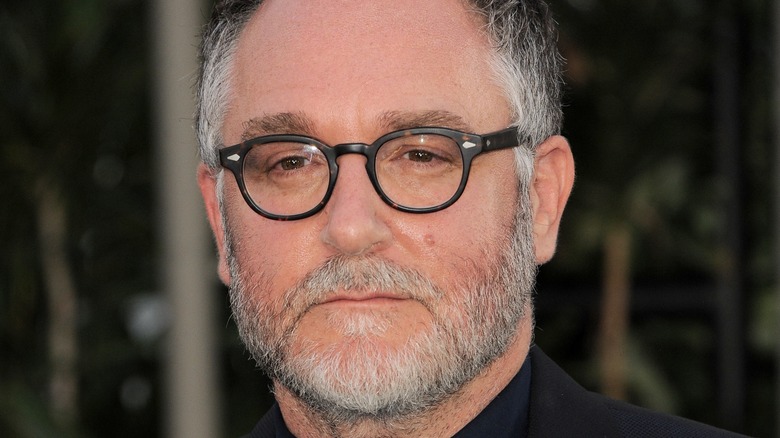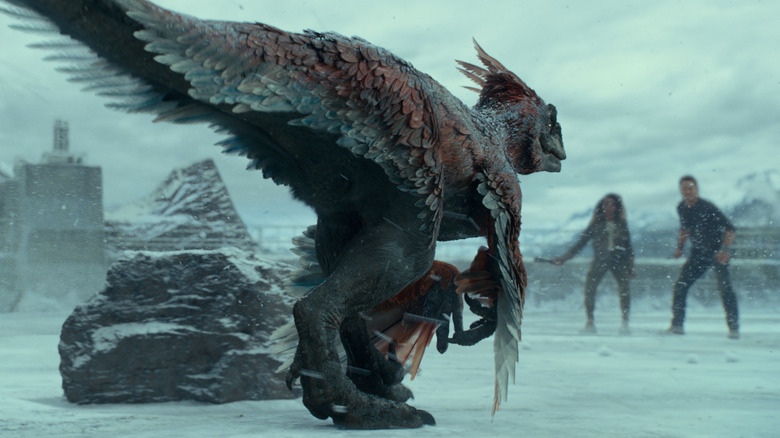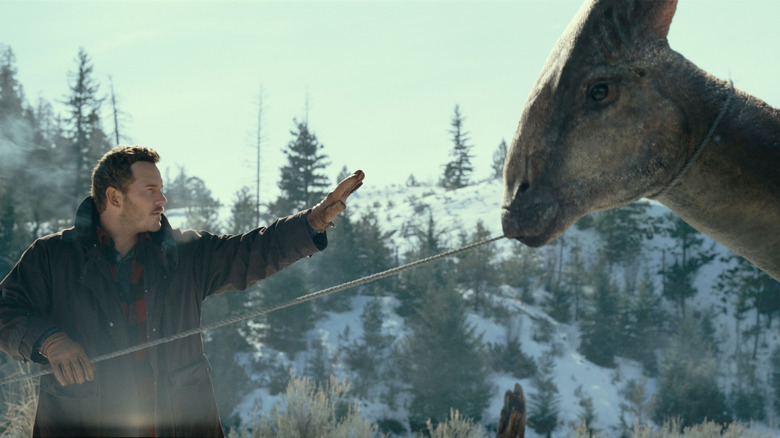Colin Trevorrow Reveals The Process Of Creating Dinosaurs With A Paleontologist In The Jurassic World Trilogy - Interview
"Jurassic World Dominion" finally plays out the trilogy's own take on the age-old question: Did dinosaurs really have feathers? Scientists have gone back and forth on this subject since the tail end of the first "Jurassic Park" trilogy. While it's unknown just how many dinosaurs had feathers, it's hard to deny the fossilized evidence that at least certain species carried this particular trait. Until now, the "Jurassic Park" and "Jurassic World" trilogies have opted for the more standard reptilian approach. But for the final "Jurassic World" film, director Colin Trevorrow wanted to give the fans (and dino aficionados) what they wanted.
During an interview with our sister site Slashfilm, Colin Trevorrow discussed the process of creating the feathered "Jurassic World" dinosaurs with the help of the trilogy's paleontologist. He also dove into the reasoning behind portraying the T-Rex in a heroic light and the reasons for placing a few snowy dinosaur scenes in "Jurassic World Dominion."
Digging up the feathery fossils
"We wanted feathered dinosaurs in the third movie," Colin Trevorrow said when asked about aspects of the dinosaurs that he wanted to include in the film. "Fans who know paleontology have been asking [about that] for a long time — and rightly asking for it. But I wanted to make sure that it was justified narratively in the context of the lore." The director didn't just want to include it for the sake of including it; it needed to fit with the story.
"It was already established that there was frog DNA in the genome, and in this film, because we were going to BioSyn, that had new advancements, that it made sense that they would've created them," Trevorrow explained. "But for me, it was the most exciting, because I hadn't really been able to design a new kind of dinosaur from scratch ... we know this is going to be embedded in the memories of children for a very long time, and it's going to be toys, and they're going to believe this is what the animal looked like."
Of course, the director couldn't do it alone. Authenticity is integral to a franchise like "Jurassic World," and the creators made sure to consult with the experts. Trevorrow added, "We consulted with our paleontologist, and really tried to find a balance between real and awesome-movie-scary."
Tinkering with the T-Rex
On the inclusion of the scenes in the snow, Colin Trevorrow said, "It was about just showing how displaced they are, and how probably a raptor like Blue would be shocked and then realize, 'Oh, I have to adapt. I have to adjust for this,' because she doesn't want to go too far away from Owen." He added, "Once we took them off the island, I didn't want any of them to be comfortable, because I want the audience to really want them to find a home, to find safety. Because hopefully, that's where we can all land."
Though it seems like the T-Rex has become a hero of sorts in the follow-up trilogy, Trevorrow was quick to point out that dinosaurs were behaving as any species fighting for dominance and survival would. "I know that the T-rex is the hero to us because of 'Jurassic Park.' I don't consider dinosaurs actual villains or actual heroes," he explained. "They're predators and prey. We always try to create a dynamic, unless it's some freak of science, like the hybrids that were created. This movie doesn't have any hybrids. It's real dinosaurs that are in the paleontological record." Now, that's not to say the dinosaurs don't create bonds (even with humans), but at the end of the day, survival is the key motivation — whether we see them as heroes or villains is our own perspective.
"Jurassic World Dominion" is now playing in theaters.


